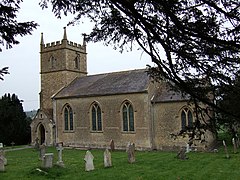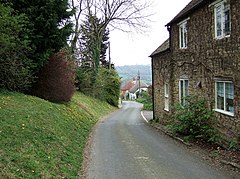Human settlement in England
| Stoke Trister | |
|---|---|
 Stoke Trister — Parish Church of St Andrew Stoke Trister — Parish Church of St Andrew | |
 Stoke Trister Village Street Stoke Trister Village Street | |
 | |
| Population | 313 (2011) |
| OS grid reference | ST735285 |
| District | |
| Shire county | |
| Region | |
| Country | England |
| Sovereign state | United Kingdom |
| Post town | WINCANTON |
| Postcode district | BA9 |
| Dialling code | 01963 |
| Police | Avon and Somerset |
| Fire | Devon and Somerset |
| Ambulance | South Western |
| UK Parliament | |
| 51°03′19″N 2°22′46″W / 51.0552°N 2.3794°W / 51.0552; -2.3794 | |
Stoke Trister is a village and civil parish 2 miles (3 km) south-east of Wincanton and 5 miles (8 km) north-west of Gillingham close to the Dorset border in the South Somerset district of Somerset, England. The parish includes the hamlet of Bayford.
History
The Stoke part of the name means place or dairy farm with the Trister part being a corruption of the name of Richard del Estre who was lord of the manor in the 12th century. Stoke Trister passed with Cucklington to the Phelips family in 1765 and was then held with Montacute.
The parish of Stoke Trister was part of the Norton Ferris Hundred.
The manor house, which was built in the 16th century, is now Stoke Farm House. It was acquired around 1547 by the Earl of Pembroke and sold in 1602.
Physicwell House, which was formerly known as Horwood Well House was built around 1805.
Governance
The parish council has responsibility for local issues, including setting an annual precept (local rate) to cover the council’s operating costs and producing annual accounts for public scrutiny. The parish council evaluates local planning applications and works with the local police, district council officers, and neighbourhood watch groups on matters of crime, security, and traffic. The parish council's role also includes initiating projects for the maintenance and repair of parish facilities, as well as consulting with the district council on the maintenance, repair, and improvement of highways, drainage, footpaths, public transport, and street cleaning. Conservation matters (including trees and listed buildings) and environmental issues are also the responsibility of the council.
The village falls within the Non-metropolitan district of South Somerset, which was formed on 1 April 1974 under the Local Government Act 1972, having previously been part of Wincanton Rural District. The district council is responsible for local planning and building control, local roads, council housing, environmental health, markets and fairs, refuse collection and recycling, cemeteries and crematoria, leisure services, parks, and tourism.
Somerset County Council is responsible for running the largest and most expensive local services such as education, social services, libraries, main roads, public transport, policing and fire services, trading standards, waste disposal and strategic planning.
It is also part of the Glastonbury and Somerton county constituency represented in the House of Commons of the Parliament of the United Kingdom. It elects one Member of Parliament (MP) by the first past the post system of election.
Religious sites
The Church of St Andrew dates from 1841 and has been designated by English Heritage as a Grade II listed building.
References
- "Statistics for Wards, LSOAs and Parishes — SUMMARY Profiles" (Excel). Somerset Intelligence. Retrieved 4 January 2014.
- Bush, Robin (1994). Somerset: The Complete Guide. Dovecote Press. pp. 198. ISBN 1-874336-26-1.
- "Somerset Hundreds". GENUKI. Retrieved 18 October 2011.
- Historic England. "Stoke Farm House (1274193)". National Heritage List for England. Retrieved 28 February 2009.
- Historic England. "Physicwell House (1238359)". National Heritage List for England. Retrieved 28 February 2009.
- "Wincanton RD". A vision of Britain Through Time. University of Portsmouth. Retrieved 4 January 2014.
- Historic England. "Church of St Andrew (1238427)". National Heritage List for England. Retrieved 8 February 2008.
